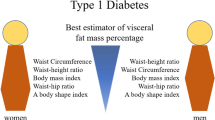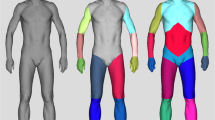Abstract
Objective:
To compare the predictive role of abdominal fat distribution by computed tomography (CT) with that of total abdominal fat by sagittal abdominal diameter (SAD) on cardiovascular risk in severe obesity.
Design:
A cross-sectional, clinical study.
Subjects:
64 males and 64 females, aged 42±15 years (mean±s.d.; range 18–75 years), BMI (kg/m2) 41.7±5.3 (30.2–57.6).
Measurements:
Blood glucose, total cholesterol, high-density lipoprotein (HDL) cholesterol, low-density lipoprotein (LDL) cholesterol, triglycerides (TGLs), insulin (IRI), insulin resistance (HOMA-IR), slice areas (cm2) of total (tSAT), superficial (sSAT) and deep subcutaneous adipose tissue (dSAT), visceral adipose tissue (VAT) and SAD (mm) by CT.
Results:
The sSAT depot was negatively associated with blood glucose, HOMA-IR, LDL cholesterol and TGLs, whereas dSAT was negatively associated with HDL cholesterol. VAT was associated with blood glucose and HOMA-IR, whereas SAD was associated with all variables evaluated. In males, VAT was associated with blood glucose (r2=0.12, P<0.01), SAD was associated with blood glucose (r2=0.67, P<0.01), IRI (r2=0.65, P<0.05), and HOMA-IR (r2=0.67, P<0.01). In females, sSAT was negatively associated with blood glucose (r2=0.63, P<0.05), whereas VAT was associated positively with blood glucose (r2=0.21, P< 0.001), total cholesterol (r2=0.16, P<0.01), LDL cholesterol (r2=0.20, P<0.001) and TGLs (r2=0.12, P<0.01). SAD was associated positively with IRI (r2=0.52, P<0.05), HOMA-IR (r2=0.53, P<0.05), total cholesterol (r2=0.52, P<0.05), LDL cholesterol (r2=0.54, P<0.01), TGLs (r2=0.52, P<0.05) and negatively to HDL cholesterol (r2=0.51, P<0.001).
Conclusion:
When compared with CT-based measures of abdominal fat compartments, SAD is a more predictive indicator of cardiovascular risk in severe obesity.
This is a preview of subscription content, access via your institution
Access options
Subscribe to this journal
Receive 12 print issues and online access
$259.00 per year
only $21.58 per issue
Buy this article
- Purchase on Springer Link
- Instant access to full article PDF
Prices may be subject to local taxes which are calculated during checkout
Similar content being viewed by others
References
Despres JP . Abdominal obesity as important component of insulin-resistance syndrome. Nutrition 1993; 9: 452–459.
Kissebah AH, Krakower GR . Regional adiposity and morbidity. Physiol Rev 1994; 74: 761–811.
Abate N, Garg A, Peshock RM, Stray-Gundersen J, Grundy SM . Relatioships of generalized and regional adiposity to insulin sensitivity in men. J Clin Invest 1995; 96: 88–98.
Kelley DE, Leland Thaete F, Troost F, Huwe T, Goodpaster BH . Subdivision of subcutaneous abdominal adipose tissue and insulin resistance. Am J Physiol Endocrinol Metab 2000; 278: 941–948.
Ross R, Freeman J, Hudson R, Janssen I . Abdominal adiposity, muscle composition, and insulin resistance in premenopausal women. J Clin Endocrinol Metab 2002; 87: 5044–5051.
Tchernof A, Belanger C, Morisset AS, Richard C, Mailloux J, Laberge P et al. Regional differences in adipose tissue metabolism in women: minor effect of obesity and body fat distribution. Diabetes 2006; 55: 1353–1360.
Enevoldsen LH, Simonsen L, Stallknecht B, Galbo H, Bulow J . In vivo human lipolytic activity in preperitoneal and subdivision of subcutaneous abdominal adipose tissue. Am J Physiol Endocrinol Metab 2001; 281: E1110–E1114.
Goodpaster BH, Thaete FL, Simoneau JA, Kelley DE . Subcutaneous abdominal fat and thigh muscle composition predict insulin sensitivity independentely of visceral fat. Diabetes 1997; 46: 1579–1585.
Marcus MA, Murphy L, Pi-Sunyer FX, Albu JB . Insulin sensitivity and serum trygliceride level in obese white and black women: relationship to visceral and truncal subcutanous fat. Metabolism 1999; 48: 194–199.
Lovejoy JC, Smith SR, Rood JC . Comparison of regional fat distribution and health risk factors in middle-aged white and African American women: the Healthy Transition Study. Obesity Res 2001; 9: 10–16.
Tulloch-Reid MK, Hanson RL, Sebring NG, Reynolds JC, Premkumar A, Genovese DJ et al. Both subcutaneous and visceral adipose tissue correlate highly with insulin resistance in African Americans. Obesity Res 2004; 12: 1352–1359.
Laaksonen DE, Kainulainen S, Rissanen A, Niskanen L . Relationships between changes in abdominal fat distribution insulin sensitivity during a very low calorie diet in abdominal obese men and women. Nutr Metab Cardiovasc Dis 2003; 13: 349–356.
Clasey JL, Bouchard C, Teates CD, Riblett JE, Thorner MO, Hartman ML et al. The use of anthropometric and dual-energy X-ray absorptiometry (DXA) measures to estimate total abdominal and abdominal visceral fat in men and women. Obes Res 1999; 7: 256–264.
Turcato E, Bosello O, Di Francesco V, Harris TB, Zoico E, Bissoli L et al. Waist circumference and abdominal sagittal diameter as surrogates of body fat distribution in the elderly: their relation with cardiovascular risk factors. Int J Obesity 2000; 24: 1005–1010.
Riserus U, Arnlov J, Brismar K, Zethelius B, Berglund L, Vessby B . Sagittal abdominal diameter is a strong anthropometric marker of insulin resistance and hyperproinsulinemia in obese men. Diabetes Care 2004; 27: 2041–2046.
Matthew DR, Rudenski AS, Naylor BA, Treacher DF, Turner RC . Homeostasis model assessment: insulin resistance and β-cell function from fasting plasma glucose and insulin concentrations in man. Diabetologia 1985; 28: 412–419.
Deschenes D, Couture P, Dupont P, Tchernof A . Subdivision of the subcutaneous adipose tissue compartment and lipid-lipoprotein levels in women. Obes Res 2003; 11: 469–476.
Ohrvall M, Berglund L, Vessby B . Sagittal abdominal diameter compared with other anthropometric measurements in relation to cardiovascular risk. Int J Obesity 2000; 19: 497–501.
Kahn HS, Austin H, Williamson DF, Arensberg D . Simple anthropometric indices associated with ischemic heart disease. J Clin Epidemiol 1996; 49: 1017–1024.
Gustat J, Elkasabany A, Srinivasan S, Berenson GS . Relation of abdominal height to cardiovascular risks factors in young adults: the Bogalusa heart study. Am J Epidemiol 2000; 151: 885–891.
Montague CT, O'Rahilly S . The perils of portliness: causes and consequences of visceral adiposity. Diabetes 2000; 49: 883–888.
Smith SR, Lovejoy JC, Greenway F, Ryan D, deLonge J, de la Bretonne J et al. Contributions of total body fat, abdominal subcutaneous adipose tissue compartments, and visceral adipose tissue to the metabolic complications of obesity. Metabolism 2001; 50: 425–435.
Minocci A, Guzzaloni G, Marzullo P, Savia G, Tagliaferri A, Berselli ME et al. Abdominal fat index by ultrasound does not estimate the metabolic risk factors of cardiovascular disease better than waist circumference in severe obesity. Diabetes Metab 2005; 31: 471–477.
Storti KL, Brach JS, Fitzgerald SJ, Bunker CH, Kriska AM . Relationship among body composition measures in community-dwelling older women. Obesity 2006; 14: 244–251.
Smith DA, Ness EM, Herbert R, Schechter CB, Phillips RA, Diamond JA et al. Abdominal diameter index: a more powerful anthropometric measure for prevalent coronary heart disease risk in adult males. Diebetes Obes Metab 2005; 7: 370–380.
Iribarren C, Darbinian JA, Lo JC, Fireman BH, Go AS . Value of sagittal abdominal diameter in coronary heart disease risk assessment: cohort study in a large, multiethnic population. Am J Epidemiol 2006; 15: 1150–1159.
Kullberg J, von Below C, Lonn L, Lind L, Ahistrom H, Johansson L . Practical approach for estimation of subcutaneous and visceral adipose tissue. Clin Physiol Funct Imaging 2007; 27: 148–153.
Sjostrom L . Methods for measurements of the total and visceral adipose tissue volume and relationship between visceral fat and disease in 1006 severely obese subjects. In: Oomura Y, Tarui S, Inoue S, Shimazu T (eds). Progress in Obesity Research 1990. John Libbey: London, 1991, pp 323–334.
Seidell JC, Andres R, Sorkin JD, Muller C . The sagittal waist diameter and mortality in men: the Baltimore Longitudinal Study on Aging. Int J Obes 1994; 18: 61–67.
Bergman RN, Kim SP, Hsu IR, Catalano KJ, Chiu JD, Kabir M et al. Abdominal obesity: role in the pathophysiology and metabolic disease and cardiovascular risk. Am J Med 2007; 120 (2 suppl 1): S3–S8; discussion S29–32.
Thamer C, Machann J, Stefan N, Haap M, Schafer S, Brenner S et al. High visceral fat mass and high liver fat are associated with resistance to lifestyle intervention. Obesity 2007; 15: 531–538.
Brochu M, Starling RD, Tchernof A, Matthews DE, Garcia-Rubi E, Poehlman ET . Visceral adipose tissue is an independent correlate of glucose disposal in older obese postmenopausal women. J Clin Endocrinol Metab 2000; 85: 2378–2384.
Tai ES, Lau TN, Ho SC, Fok AC, Tan CE . Body fat distribution and cardiovascular risk in normal weight women. Associations with insulin resistance, lipids and plasma leptin. Int J Obesity 2000; 24: 751–757.
Wajchenberg BL . Subcutaneous and visceral adipose tissue: their relation to the metabolic syndrome. Endocr Rev 2000; 21: 697–738.
Ross R, Fortier L, Hudson R . Separate associations between visceral and subcutaneous adipose tissue distribution, insulin and glucose levels in obese women. Diabetes Care 1996; 19: 1404–1411.
Wagenknecht LE, Langefeld CD, Scherzinger AL, Norris JM, Haffner SM, Saad MF et al. Insulin sensitivity, insulin secretion, and abdominal fat: the Insulin Resistance Atherosclerosis Study (IRAS) Family Study. Diabetes 2003; 52: 2490–2496.
Goodpaster BH, Krishnaswami S, Harris TB, Katsiaras A, Kritchevsky SB, Simonsick EM et al. Obesity, regional body fat distribution, and the metabolic syndrome in older men and women. Arch Intern Med 2005; 165: 777–783.
Walker GE, Verti B, Marzullo P, Savia G, Mencarelli M, Zurleni F et al. Deep subcutaneous adipose tissue: a distinct abdominal adipose depot. Obesity 2007; 15: 1933–1943.
Author information
Authors and Affiliations
Corresponding author
Rights and permissions
About this article
Cite this article
Guzzaloni, G., Minocci, A., Marzullo, P. et al. Sagittal abdominal diameter is more predictive of cardiovascular risk than abdominal fat compartments in severe obesity. Int J Obes 33, 233–238 (2009). https://doi.org/10.1038/ijo.2008.271
Received:
Revised:
Accepted:
Published:
Issue Date:
DOI: https://doi.org/10.1038/ijo.2008.271
Keywords
This article is cited by
-
Probiotics during weaning: a follow-up study on effects on body composition and metabolic markers at school age
European Journal of Nutrition (2015)
-
Gender-, Age-, and BMI-Specific Threshold Values of Sagittal Abdominal Diameter Obtained by Artificial Neural Networks
Journal of Medical and Biological Engineering (2015)
-
Lean mass is the strongest predictor of bone mineral content in type-2 diabetes and normal individuals: an eastern India perspective
Journal of Diabetes & Metabolic Disorders (2014)
-
Relationships between cardiorespiratory fitness, metabolic control, and fat distribution in type 2 diabetes subjects
Acta Diabetologica (2014)
-
Association of body mass index, sagittal abdominal diameter and waist-hip ratio with cardiometabolic risk factors and adipocytokines in Arab children and adolescents
BMC Pediatrics (2012)



